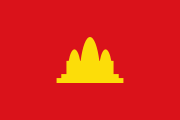Democratic Kampuchea coalition government
| រដ្ឋាភិបាល ចំរុះ កម្ពុជាប្រជាធិបតេយ្យ | |||||
|
Odthaphbeal Chamrouh Kâmpŭchéa Brachathibey |
|||||
| Democratic Kampuchea coalition government | |||||
| 1982-1993 | |||||
|
|||||
| Official language | Khmer | ||||
| Capital | n / a, de iure Phnom Penh | ||||
| Form of government | People's Republic | ||||
| Government system |
Provisional government , government in exile |
||||
| Head of state | President Norodom Sihanouk (1982–1987) | ||||
| Head of government | Prime Minister Son Sann (1981-1993) | ||||
| surface | 181,040 km² | ||||
| currency | Riel | ||||
| National anthem |
Dap Prampi Mesa Chokchey ដប់ប្រាំ ពីរ មេសា មហា ជោគជ័យ Great victorious April 17th |
||||
| Time zone | UTC + 7h | ||||
The Coalition Government of Democratic Kampuchea ( khm. រដ្ឋាភិបាល ចំរុះ កម្ពុជា ប្រជា ធិ ប តេ យ ្ , Odthaphbeal Chamrouh Kâmpŭchéa Brachathibey ; Engl. Coalition Government of Democratic Kampuchea , CGDK;. French Gouvernement de coalition du démocratique Kampuchea , GCKD), 1990 National Government of Cambodia renamed (khm រដ្ឋាភិបាល. ជាតិ នៃ កម្ពុជា, Rodthaphibeal cheate nei Kâmpŭchéa ; engl. National government of Cambodia , NGC;. French Gouvernement du national Cambodge , GNC), was a coalition government in exile during the existence of the people's Republic of Kampuchea and was composed of three Cambodian political factions FUNCINPEC of Prince Norodom Sihanouk , the Democratic Kampuchea Party (PDK) of the Khmer Rouge and the Khmer National Liberation Front (KPNLF) together. It was founded in 1982 and has been the internationally recognized government of Cambodia for most of its existence.
International recognition
The coalition's signing ceremony was held on June 22, 1982 in Kuala Lumpur . President of the coalition was Prince Norodom Sihanouk, Prime Minister the leader of the KPNLF Son Sann and Foreign Minister the leader of the PDK Khieu Samphan .

The Cambodian seat in the United Nations , held by the Khmer Rouge, was given to the CGDK after it was recognized as the legitimate Cambodian government. The western states had rejected the proposal of the Eastern bloc states to transfer the Cambodian seat to the regime of the People's Republic of Cambodia installed by Vietnam : at the UN General Assembly, 91 states rejected the proposal, 29 agreed and 26 abstained. In 1981 the seat was awarded to the Khmer Rouge by 77 votes to 37, with 31 abstentions. The CGDK was also recognized by North Korea , whose leader Kim Il-sung Sihanouk offered exile in 1970 after he was pushed away by Lon Nol . During a meeting with Sihanouk on April 10, 1986 in Pyongyang , Kim Il-sung assured Sihanouk that North Korea continued to regard him as the legitimate head of state of Cambodia.
history
In the late 1980s and early 1990s, even before the founding of the CGDK, the resistance groups of Son Sann and Norodom Sihanouk , KPNLF and FUNCINPEC, respectively, received military and financial support from the United States as part of its Reagan Doctrine in an effort to achieve the Combat Vietnamese engagement in Cambodia. In 1984 and 1985, however, the Vietnamese army's offensives weakened the CGDK troops to such an extent that the two non-communist parties were virtually eliminated as military actors and the Khmer Rouge was still the only serious military force of the CGDK. One of the main architects of the Reagan Doctrine, Michael Johns of the Heritage Foundation , visited the troops of Sonn Sann and Sihanouk in Cambodia in 1987 and, on his return to Washington , urged expanded support for the resistance groups KPNLF and FUNCINPEC as a third alternative to the Khmer Rouge the government installed by Vietnam.
Although the PDK, since 1982, the successor to the 1981 resolution Communist Party of Kampuchea was diplomatically largely isolated, was their National Army of Democratic Kampuchea (Engl. National Army of Democratic Kampuchea , NADK) is the largest and most effective fighting force the CGDK. In 1987, Prince Sihanouk, frustrated by ASEAN's continued recognition of Democratic Kampuchea and its military support from China, suspended his position as President of the CGDK, raising hopes in Hanoi and Moscow that he would leave the coalition.
Ahead of the support of the United Nations Paris Peace Agreement of 1991, the CGDK 1990 appointed National Government of Cambodia (Engl. National Government of Cambodia , NGC) around. Then the People's Republic of Kampuchea , renamed the State of Cambodia , was placed under the administration of the UN (UNTAC) in order to hold free elections in 1993. After this, the NGC was dissolved and the monarchy was restored in Cambodia. In June 1994 the Khmer Rouge formed an internationally unrecognized counter-government under the name Provisional Government of National Union and National Salvation of Cambodia .
Web links
- Coalition Government of Democratic Kampuchea. In: Country Studies Series. Library of Congress Country Studies , Federal Research Division
Individual evidence
- ↑ Timothy M. Carney : Kampuchea in 1982: Political and Military Escalation. In: Asian Survey. Vol. 23, No. 1, 1983, p. 76.
- ^ Chief of States and Cabinet Members of Foreign States. CIA , January 1985 (PDF; 7.8 MB).
- ↑ Timothy M. Carney: Kampuchea in 1982: Political and Military Escalation. In: Asian Survey. Vol. 23, No. 1, 1983, p. 80.
- ^ Daniel Bultmann: Inside Cambodian Insurgency. A Sociological Perspective on Civil Wars and Conflict. Ashgate, Burlington, VT / Farnham 2015, ISBN 978-1-4724-4307-6 .
- ^ Bertil Lintner: Odd couple: The royal and the Red. In: Asia Times . October 31, 2007.
- ^ Shaun Narine: Explaining ASEAN: Regionalism in Southeast Asia. Lynne Rienner, London 2002, ISBN 978-1-58826-129-8 ( limited preview in Google Book Search).
- ↑ Michael Johns: Cambodia at a Crossroads ( Memento of November 24, 2002 in the Internet Archive ). In: The World and I. February 1988.
- ^ Coalition Government of Democratic Kampuchea. In: Country Studies Series. Library of Congress Country Studies , Federal Research Division.



